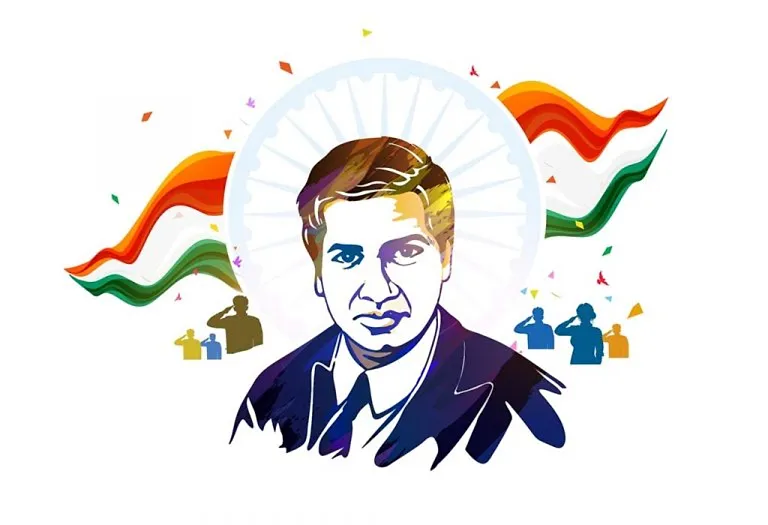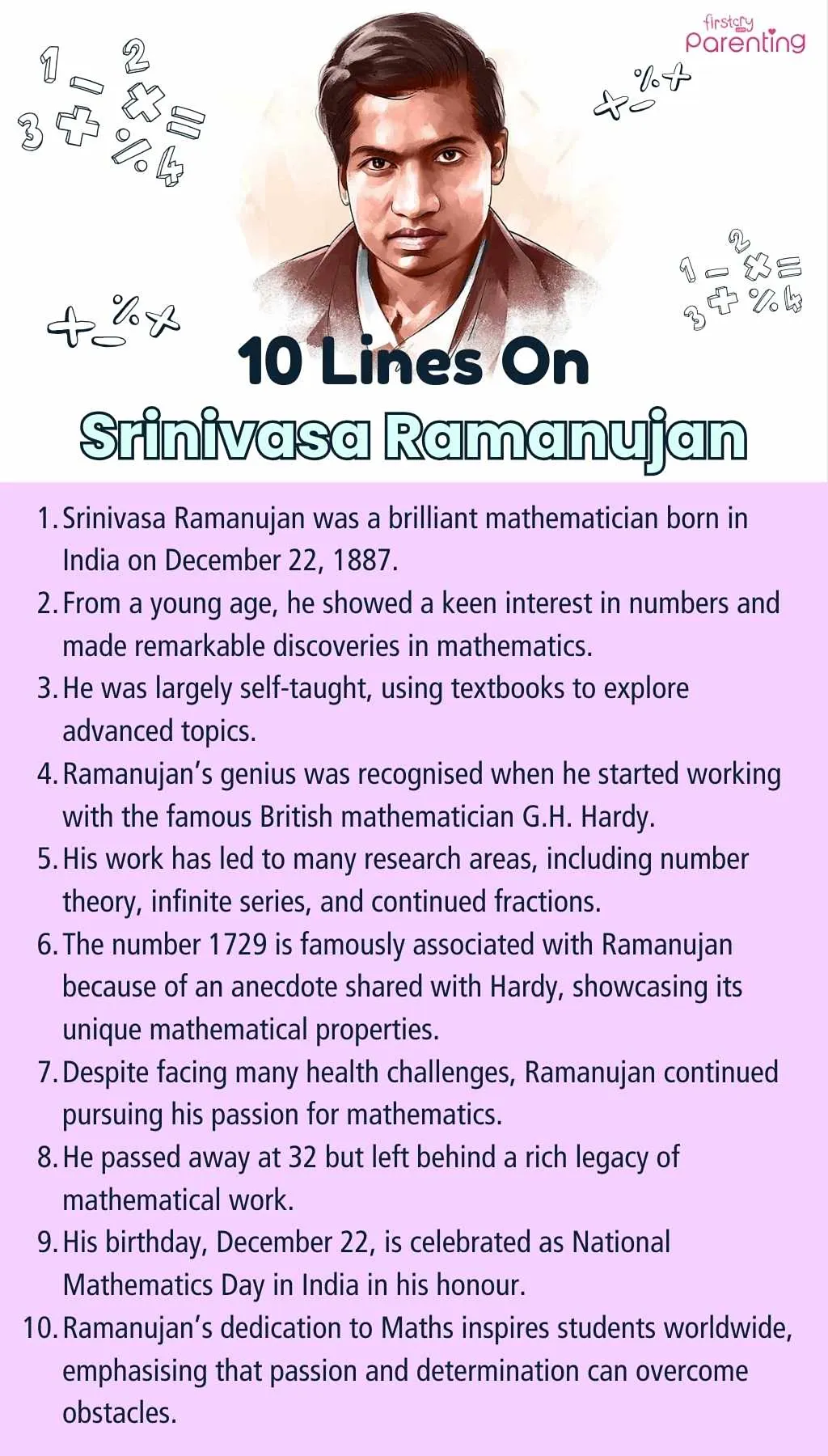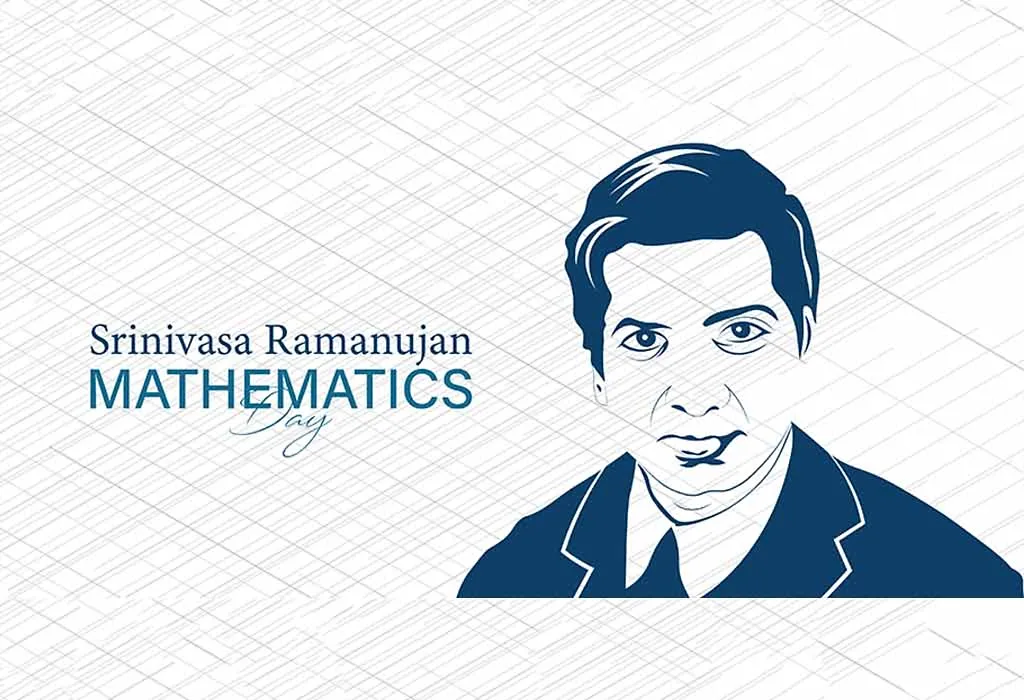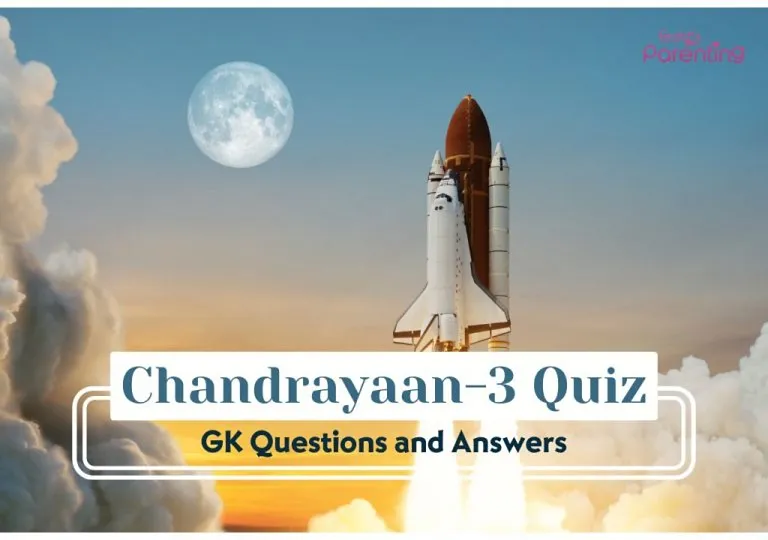Essay on Srinivasa Ramanujan – 10 Lines, Short and Long Essay for Children and Students
When we explore the world of mathematics, some names shine brightly, such as Srinivasa Ramanujan. A genius from India, he has contributed immensely to the world of numbers and equations. This essay on Srinivasa Ramanujan in English aims to bring this extraordinary mathematician’s life, achievements, and dedication closer. Essay writing helps improve comprehension and communication skills, especially when targeted at children and students. It encourages research, clarity of thought, and the articulation of ideas. As we delve deep into the essay for children and students, let’s take a moment to appreciate the essence of essay writing and its ability to enhance our understanding of subjects, especially figures as pivotal as Ramanujan.
Key Points to Remember When Writing an Essay on Srinivasa Ramanujan
Writing an essay on great mathematician Srinivasa Ramanujan requires a keen understanding of his life, contributions, and significance. Before delving deep into the topic, it’s essential to remember some pivotal aspects to paint a comprehensive and authentic picture of this genius mathematician.
- Historical Context: Understand the era in which Ramanujan lived. This can provide insight into his challenges and the socio-cultural environment of that time.
- Early Life: Highlight his early years, emphasising his prodigious aptitude for mathematics even as a young boy and the self-study that laid the foundation of his future works.
- Major Contributions: It’s crucial to mention his significant works, like the Ramanujan Prime, the Ramanujan Theta function, and his work on infinite series.
- Collaboration with G.H. Hardy: Detail his collaboration with the noted British mathematician G.H. Hardy, a turning point in Ramanujan’s life. Their professional relationship and mutual respect can be a focal point.
- Challenges: Address the struggles he faced, both health-wise and in his career, including his initial rejection by the Indian academic community and his battle with tuberculosis.
- Legacy: Emphasise the lasting impact of Ramanujan’s contributions to the world of mathematics and how his works inspire mathematicians today.
- Personal Anecdotes: Including personal stories or anecdotes can make the essay more engaging. For instance, the story of how he described 1729 as the smallest number expressible as the sum of two cubes in two different ways can pique the reader’s interest.
- Quotations: Incorporate some of his famous quotes or statements, which can reflect his passion for mathematics and his unique perspective on the subject. Summarise his legacy and reiterate the importance of his contributions to modern mathematics. It’s also an excellent place to reflect on the inspiration students and children can draw from his life and dedication.
10 Lines on Srinivasa Ramanujan
With his unparalleled genius, Srinivasa Ramanujan left an indelible mark on the world of mathematics. For younger readers and those just being introduced to this great personality, here are a few lines about Srinivasa Ramanujan, perfect as an essay for lower primary class students.
- Srinivasa Ramanujan was a brilliant mathematician born in India on December 22, 1887.
- From a young age, he showed a keen interest in numbers and made remarkable discoveries in mathematics.
- He was largely self-taught, using textbooks to explore advanced topics.
- Ramanujan’s genius was recognised when he started working with the famous British mathematician G.H. Hardy.
- His work has led to many research areas, including number theory, infinite series, and continued fractions.
- The number 1729 is famously associated with Ramanujan because of an anecdote shared with Hardy, showcasing its unique mathematical properties.
- Despite facing many health challenges, Ramanujan continued pursuing his passion for mathematics.
- He passed away at 32 but left behind a rich legacy of mathematical work.
- His birthday, December 22, is celebrated as National Mathematics Day in India in his honour.
- Ramanujan’s dedication to Maths inspires students worldwide, emphasising that passion and determination can overcome obstacles.
Paragraph on Srinivasa Ramanujan
Ramanujan’s journey is filled with discovery and passion and is a testament to the wonders of human potential. Diving into a paragraph about Srinivasa Ramanujan, we find a tale of perseverance and innate talent.
Mathematics has witnessed many luminaries, but few shine as brightly as Srinivasa Ramanujan. Born in 1887 in Erode, India, Ramanujan’s love for numbers was evident early on. Largely self-taught, he ventured into complex mathematical territories, making groundbreaking discoveries in number theory, infinite series, and continued fractions. Despite facing numerous health and professional challenges, he remained undeterred, collaborating with eminent mathematicians like G.H. Hardy. His contributions have left an enduring legacy, inspiring generations to explore the infinite world of mathematics.
Srinivasa Ramanujan Essay in 100 Words
Delving into the intricate world of mathematics, certain names resonate with genius and exceptional talent. Srinivasa Ramanujan is undoubtedly one of those luminaries. Let’s encapsulate his extraordinary journey in a concise essay.
Srinivasa Ramanujan, born in Erode, India, in 1887, was a self-taught mathematical prodigy. His insatiable curiosity led him to explore complex mathematical domains, significantly contributing to number theory, infinite series, and more. Recognised by British mathematician G.H. Hardy, their collaboration yielded invaluable mathematical insights. Despite battling health issues, Ramanujan’s passion for mathematics never waned. His discoveries, many of which continue to be the subject of research today, stand as a testament to his unparalleled genius. Today, his legacy is a beacon of inspiration, urging us to pursue our passions with enthusiasm and dedication.
Short Essay on Srinivasa Ramanujan’s Contribution to Mathematics
Few names evoke as much reverence and admiration in the vast expanse of mathematical history as Srinivasa Ramanujan. His remarkable journey from a small town in India to the hallowed halls of Cambridge is a tale of pure passion, dedication, and genius. As we delve into a brief exploration of his contributions to mathematics, we are reminded of the incredible depth and breadth of his work.
Srinivasa Ramanujan, largely self-taught, ventured into areas of mathematics that many found baffling. His innate talent allowed him to see patterns and relationships in numbers that eluded others. One of his most significant contributions lies in the domain of number theory, where he formulated results on partition functions and properties of prime numbers. His work on infinite series, especially those related to pi, drew widespread attention and admiration. The Ramanujan-Hardy number, 1729, is a testament to his uncanny ability to find uniqueness in seemingly ordinary numbers.
His work on continued fractions and modular forms also laid the foundation for many mathematical discoveries that followed. Despite his short life, plagued by health issues, Ramanujan’s prolific output has left a lasting legacy. His notebooks, filled with results, some of which are yet to be proven, are a testament to a mind that operated on a plane few could fathom. Today, Ramanujan’s contributions stand not just as mathematical achievements but as a testament to what passion and innate talent can achieve against all odds.
Long Essay on Srinivasa Ramanujan
Srinivasa Ramanujan, a beacon of brilliance in mathematics, emerged from humble beginnings in India to leave an indelible mark on the global mathematical community. His life and achievements are a testament to the power of raw talent, perseverance, and an unyielding passion for one’s pursuits.
Early Life and Education of Srinivasa Ramanujan
- Born on December 22, 1887, in Erode, Tamil Nadu, India, Ramanujan displayed a keen interest in mathematics from a young age.
- He was mostly self-taught, deriving complex mathematical theorems and results before turning 10.
- By 12, he had mastered advanced trigonometry and started inventing his theorems and equations.
- In his teenage years, Ramanujan came across a library copy of ‘A Synopsis of Elementary Results in Pure and Applied Mathematics’, which greatly influenced his work.
- He attended Town Higher Secondary School and later went to Government College, Kumbakonam, but dropped out due to financial constraints and health issues.
- Despite lacking formal training in mathematics, Ramanujan continued his independent research, filling notebooks with results that would later amaze the global community.
- Unfortunately, his intense focus on mathematics affected his other academic pursuits, leading him to fail in different subjects.
Srinivasa Ramanujan’s Contribution to Mathematics
- Ramanujan made groundbreaking contributions to number theory, especially regarding the distribution of prime numbers.
- He investigated the partition function, developing a way to calculate the number of ways a given integer can be expressed as the sum of positive integers.
- His work on infinite series provided new ways to approximate π, an achievement that caught the attention of the West.
- Ramanujan introduced the concept of mock theta functions, which have since become a significant area of research in mathematics.
- His collaboration with G.H. Hardy led to developing the Ramanujan-Hardy number 1729 and a deep exploration of modular forms.
- He delved into elliptic functions, continued fractions, and other complex areas, leaving behind results that still puzzle and inspire mathematicians today.
- His notebooks, filled with unproven theorems and results, remain a treasure trove for mathematicians, with some theorems still being explored and proven.
Srinivasa Ramanujan’s Achievements
- Ramanujan was elected as a Fellow of the Royal Society in 1918, a rare honour for someone with limited formal education in mathematics (4).
- His partnership with G.H. Hardy is regarded as one of the most productive collaborations in the history of mathematics.
- Ramanujan independently compiled nearly 3900 results, many of which were later proven correct and novel.
- He was awarded a Bachelor of Science “by research” from the University of Madras.
- His work laid the foundation for research areas like black holes in physics.
- Ramanujan was honoured with the release of a stamp by the Indian government to commemorate his 75th birth anniversary.
- In India, National Mathematics Day is celebrated on his birthday, December 22, in recognition of his immense contributions.
Also Read: National Mathematics Day – History, Significance and Facts
Death and Legacy of Srinivasa Ramanujan
Ramanujan returned to India in 1919, battling health issues in England. His health deteriorated further, and he tragically passed away on April 26, 1920, at the young age of 32. However, his legacy lives on. His work continues to inspire and challenge mathematicians globally. Ramanujan’s notebooks, filled with theorems, results, and mathematical musings, are still being studied, leading to discoveries and insights. Beyond his mathematical genius, Ramanujan’s life is a poignant reminder of the power of perseverance, the magic of innate talent, and the wonders that can be achieved when the two come together.
Interesting Facts About Srinivasa Ramanujan You Should Know
Srinivasa Ramanujan’s life is filled with stories of passion, dedication, and sheer genius. While his mathematical prowess is well-known, several lesser-known facets of his life make his story even more compelling.
- Child Prodigy: By age 11, Ramanujan had exhausted the mathematical knowledge of two college students who were lodgers at his home, showcasing his innate talent from a young age.
- Deep Spiritual Belief: Ramanujan attributed his mathematical abilities to divinity. He once said that the Hindu goddess Namagiri would appear in his dreams, presenting him with complex mathematical formulas, which he would verify after waking up.
- The Ramanujan Number: 1729 is famously known as the Ramanujan Number. When G.H. Hardy asked about its lack of significance, Ramanujan promptly responded that it was the smallest number expressible as the sum of two cubes in two different ways (1).
- Late Recognition: Despite his brilliance, Ramanujan faced initial rejection. He wrote to several mathematicians about his findings, but only G.H. Hardy recognised his genius and invited him to Cambridge (3).
- Unfinished Work: Ramanujan left behind three “lost” notebooks, which were discovered years after his death. These notebooks contain many results that are still being understood and proven (2).
- Cultural Impact: Ramanujan’s life story has inspired plays, films, and books. The movie The Man Who Knew Infinity, starring Dev Patel, is based on his life and relationship with G.H. Hardy.
What Will Your Child Learn From the Essay on Srinivasa Ramanujan?
Through the essay on the great mathematician Srinivasa Ramanujan, your child will gain insights into the remarkable journey of a self-taught genius. They’ll learn about the power of perseverance, the significance of chasing one’s passion, and the immense contributions an individual can make to global knowledge when driven by genuine curiosity and dedication.
FAQs
1. What is Srinivasa Ramanujan Maths Day?
Srinivasa Ramanujan Maths Day, also known as National Mathematics Day, is celebrated on December 22 every year in India to commemorate the birth anniversary of the legendary mathematician Srinivasa Ramanujan and to honour his contributions to the field of mathematics.
2. What is Srinivasa Ramanujan most well-known for?
Srinivasa Ramanujan is most renowned for his substantial contributions to number theory, infinite series, mathematical analysis, and continued fractions. Many of his results were groundbreaking and influential in further mathematical research.
3. What is Ramanujan’s most famous formula?
While Ramanujan developed numerous significant formulas, one of the most famous is his formula for partitions, notably his asymptotic series for the partition function’ p(n)p(n)’. This formula approximates the number of ways a given integer can be expressed as the sum of positive integers, disregarding the order.
In the annals of mathematical history, Srinivasa Ramanujan’s story stands out as a beacon of inspiration, illuminating the profound depths of human potential. His remarkable achievements, forged from sheer passion and innate talent, are a timeless testament to the wonders that can be realised when the human spirit remains undeterred by life’s challenges.
References/Resources:
1. Ramanujan: The Man Who Knew Infinity; ISTI; https://www.indiascienceandtechnology.gov.in/listingpage/ramanujan-man-who-knew-infinity
2. Andrews. G, Berndt. B. C, Borwein. J. M, Borwein. P; Your hit parade: the top ten most fascinating formulas in Ramanujan’s Lost notebook; ResearchGate; https://www.researchgate.net/publication/228756695_Your_hit_parade_the_top_ten_most_fascinating_formulas_in_Ramanujan’s_Lost_notebook
3. Gregersen. E; 6 Interesting Facts about Srinivasa Ramanujan; Encyclopedia Britannica; https://www.britannica.com/story/interesting-facts-about-srinivasa-ramanujan
4. Srinivasa Ramanujan; Encyclopedia Britannica; https://www.britannica.com/biography/Srinivasa-Ramanujan
Also Read:
Essay On C V Raman
Essay On Savitribai Phule
Essay On My Favourite Personality
Was This Article Helpful?
Parenting is a huge responsibility, for you as a caregiver, but also for us as a parenting content platform. We understand that and take our responsibility of creating credible content seriously. FirstCry Parenting articles are written and published only after extensive research using factually sound references to deliver quality content that is accurate, validated by experts, and completely reliable. To understand how we go about creating content that is credible, read our editorial policy here.
























